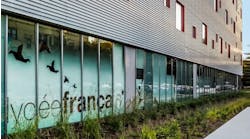Does furniture make a difference?
-The University of Minnesota found that round tables for student groupings, laptop-based technology, multiple flat-panel projection systems, and a multimedia instructor station changed the classroom experience dramatically. Teacher-student relationships deepened; teacher roles changed to that of coach; more collaborative relationships between students emerged; teachers stepped outside their "comfort zones" and changed their instructional strategies.
-The elementary principal at Maranatha Christian Academy, Brooklyn Park, Minn., replaced chairs with balls for a third-grade class; students improved their posture, enhanced their attention and concentration, improved their learning through movement, gained a sensitivity toward wellness, enjoyed active sitting, improved blood flow to their body, and strengthened core muscles. The label "attention deficit disorder" disappeared in that classroom.
-Owatonna (Minn.) Public Schools’ high school "Options Program" serves students desiring more accountability and ownership over their learning. Students, with a guide and parent(s), create a personalized graduation plan based on interests and goals. Students experience an environment that fosters creativity, increases critical thinking, enriches technology, and creates a greater sense of purpose. The existing space was transformed through the use of furniture. Hip-top tables, technology pods, modular chairs, soft furniture, movable presentation screens, and portable platforms support the curriculum delivery. Teacher’s desks and dividers were replaced with open centers, increasing student-teacher interaction. Inspirational signage and interior finish updates complement the space. Technology enhances learner-centered education and collaboration via laptops, interactive display-boards, wireless connections, projectors, cameras, etc.
-The Oswego (Ill.) Community Unit School District created "virtual learning centers" as part of Oswego High School’s renovation. Adjustable technology tables with modular seating are situated in niches off the newly created locker commons areas. During breaks and socializing, students readily access "virtual learning centers" to communicate with peers, download lessons and assignments, and upload homework through various technology devices. It’s an example of learning any time in any place.
-In the Middle East, Jordan and the United Arab Emirates are constructing new schools that support education reform. Furniture is a major emphasis for new teaching and learning delivery. Portable and flexible chairs, high/low interconnecting tables, interactive technology pods, soft modular furniture, conferencing tables, sitting cubes, portable platforms, media carts, carrels, etc. make up the high-quality furniture provided in these schools for age-appropriate learning.
